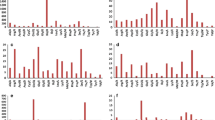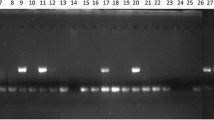Abstract
Simple sequence repeats (SSRs) defined as sequence repeat units between 1 and 6 bp occur abundantly in both coding and non-coding regions in eukaryotic genomes and these repeats can affect gene expression. In this study, ESTs (expressed sequence tags) of Betula pendula (silver birch) were analyzed for in silico mining of EST-SSRs, protein annotation, open reading frames (ORFs), designing primers, and identifying codon repetitions. In B. pendula, the frequency of ESTs containing SSRs was 7.8 % with an average of 1SSR/4. 78 kb of EST sequences. A total of 188 SSRs was identified by using MISA software and di-nucleotide SSR motifs (65.9 %) were found to be the most abundant type of repeat motif followed by tri- (27.1 %), tetra- (4.8 %), and penta- (2.2 %) motifs. Based on ORF analysis, 175 of 178 sequences were predicted as ORFs and the most frequent SSRs were detected in 5′ UTR (58.43 %), followed by in ORF (31.46 %) and in 3′ UTR (8.43 %). 102 of 178 ESTs were annotated as ribosomal protein, transport protein, membrane protein, carrier protein, binding protein, and transferase protein. For a total of 102 SSRs (57.3 %) with significant matches, a set of 102 primers (100 %) with forward and reverse strands was designed by using Primer3 software. Serine (Ser, 19.6 %) was predominant in putative encoded amino acids and most of amino acids showed nonpolar (35.3 %) nature. Our data provide resources for B. pendula and can be useful for in silico comparative analyses of Betulaceae species, including SSR mining.



Similar content being viewed by others
References
Acuña CV, Fernandez P, Villalba PV, García MN, Hopp HE, Poltri SNM (2011) Discovery, validation, and in silico functional characterization of EST-SSR markers in Eucalyptus globules. Tree Genet Genomes. doi:10.1007/s11295-011-0440-0
Asp T, Frei UK, Didion T, Nielsen KK, Lübberstedt T (2007) Frequency, type, and distribution of EST-SSRs from three genotypes of Lolium perenne, and their conservation across orthologous sequences of Festuca arundinacea, Brachypodium distachyon, and Oryza sativa. BMC Plant Biol 7:36. doi:10.1186/1471-2229-7-36
Bérubé Y, Zhuang J, Rungis D, Ralph S, Bohlmann J, Ritland K (2007) Characterization of EST-SSRs in loblolly pine and spruce. Tree Genet Genomes 3:251–259
Cardle L, Ramsay L, Milborne D, Macaulay M, Marshall D, Waugh R (2000) Computational and experimental characterization of physically clustered simple sequence repeats in plants. Genetics 156:847–854
Cordeiro GM, Casu R, McIntyre CL, Manners JM, Henry RJ (2001) Microsatellite markers from sugarcane (Saccharum spp.) ESTs cross transferable to erianthus and sorghum. Plant Sci 160:1115–1123
De Jong PC (1993) An introduction to Betula: its morphology, evolution, classification and distribution with a survey of recent work. The IDS Betula Symposium, International Dendrology Society, Susses
Ellegren H (2000) Microsatellite mutations in the germline: implications for evolutionary inference. Trends Genet 16:551–558
Filiz E, Koc I, Sakinoglu FC (2012) In silico EST-SSRs analysis in unigene of Quercus robur L. Res Plant Biol 2:1–9
Furlow JJ (1990) The genera of Betulaceae in the southeastern United States. J Arnold Arbor 71:1–67
Gupta PK, Balyan HS, Sharma PC, Ramesh B (1996) Microsatellites in plants: a new class of molecular markers. Curr Sci 70:45–54
Gupta PK, Rustgi S, Sharma S, Singh R, Kumar N, Balyan HS (2003) EST-SSRs for transferability, polymorphism and genetic diversity in bread wheat. Mol Genet Genom 270:315–323
Gupta S, Shukla R, Roy S, Sen N, Sharma A (2010a) In silico SSR and FDM analysis through EST sequences in Ocimum basilicum. POJ 3:121–128
Gupta S, Tripathi KP, Roy S, Sharma A (2010b) Analysis of unigene derived microsatellite markers in family Solanaceae. Bioinformation 5:113–121
Huang X, Madan A (1999) CAP3: a DNA sequence assembly program. Genome Res 9:868–877
Kalia RK, Rai MK, Kalia S, Singh R, Dhawan AK (2011) Microsatellite markers: an overview of the recent progress in plants. Euphytica 177:309–334
Kota R, Varshney RK, Thiel T, Dehmer KJ, Graner A (2001) Generation and comparison of EST-derived SSRs and SNPs in barley (Hordeum vulgare L.). Hereditas 135:145–151
Lawson MJ, Zhang L (2006) Distinct patterns of SSR distribution in the Arabidopsis thaliana and rice genomes. Genome Biol 7:R14
Li YC, Korol AB, Fahima T, Beiles A, Nevo E (2002) Microsatellites: genomic distribution, putative functions and mutational mechanisms: a review. Mol Ecol 11:2453–2465
Li YC, Korol AB, Fahima T, Nevo E (2004) Microsatellites within genes: structure, function, and evolution. Mol Biol Evol 21:991–1007
Lü YD, Cai CP, Wang L, Lin SY, Zhao L, Tian LL, Lü JH, Zhang TZ, Guo WZ (2010) Mining, characterization, and exploitation of EST-derived microsatellites in Gossypium barbadense. Chin Sci Bull 55:1889–1893
Martín C, Parra T, Clemente-Muñoz M, Hernandez-Bermejo E (2008) Genetic diversity and structure of the endangered Betula pendula subsp. fontqueri populations in the south of Spain. Silva Fenn 42:487–498
Metzgar D, Bytof J, Wills C (2000) Selection against frameshift mutations limits microsatellite expansion in coding DNA. Genome Res 10:72–80
Morgante M, Hanafey M, Powell W (2002) Microsatellite are preferentially associated with nonrepetitive DNA in plant genomes. Nat Genet 30:194–200
Palliyarakkal MK, Ramaswamy M, Vadivel A (2011) Microsatellites in palm (Arecaceae) sequences. Bioinformation 7:347–351
Powell W, Machray GC, Provan J (1996) Polymorphism revealed by simple sequence repeats. Trends Plant Sci 1:215–222
Qiu L, Yang C, Tian B, Yang JB, Liu A (2010) Exploiting EST databases for the development and characterization of EST-SSR markers in castor bean (Ricinus communis L.). BMC Plant Biol 10:278
Rungis D, Bérubé Y, Zhuang J, Ralph S, Ritland CE, Ellis BE, Douglas C, Bohlmann J, Ritland K (2004) Robust simple sequence repeat (SSR) markers for spruce (Picea spp.) from expressed sequence tags (ESTs). Theor Appl Genet 109:1283–1294
Schenk MF, Thienpont CN, Koopman WJM, Gilissen LJWJ, Smulders MJM (2008) Phylogenetic relationships in Betula (Betulaceae) based on AFLP markers. Tree Genet Genomes 4:911–924
Scott KD, Eggler P, Seaton G, Rossetto M, Ablett EM, Lee LS, Henry RJ (2000) Analysis of SSRs derived from grape ESTs. Theor Appl Genet 100:723–726
Shanker A, Bhargava A, Bajpai R, Singh S, Srivastava S, Sharma V (2007) Bioinformatically mined simple sequence repeats in UniGene of Citrus sinensis. Sci Hortic 113:353–361
Tautz D (1993) Notes on the definition and nomenclature of tandemly repetitive DNA sequences. In: Pena SDJ, Chakraborty R, Epplen JT, Jeffreys AJ (eds) DNA fingerprinting: state of science. Birkhäuser Verlag, Basel, pp 21–28
Tautz D, Renz M (1984) Simple sequence repeats are ubiquitous repetitive components of eukaryotic genomes. Nucleic Acids Res 12:4127–4138
Toth G, Ga´spa´ri Z Z, Jurka J (2000) Microsatellites in different eukaryotic genomes: survey and analysis. Genome Res 10:967–981
Varshney RK, Thiel T, Stein N, Langridge P, Graner A (2002) In silico analysis on frequency and distribution of microsatellites in ESTs of some cereal species. Cell Mol Biol Lett 7:537–546
Author information
Authors and Affiliations
Corresponding author
Additional information
The online version is available at http://www.springerlink.com
Corresponding editor: Hu Yanbo
Rights and permissions
About this article
Cite this article
Filiz, E., Dogan, I. & Ozyigit, I.I. Analysis of EST-SSRs in silver birch (Betula pendula Roth.). J. For. Res. 27, 639–646 (2016). https://doi.org/10.1007/s11676-015-0182-1
Received:
Accepted:
Published:
Issue Date:
DOI: https://doi.org/10.1007/s11676-015-0182-1




